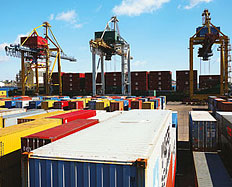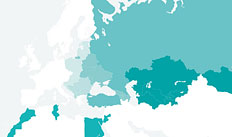COUNTRY ASSESSMENTS
Romania
HIGHLIGHTS OF THE PAST YEAR
- Growth has resumed and macroeconomic stability has been preserved. The growth rate in 2011 was influenced by an exceptional performance in agriculture, and inflation fell to historically low levels, but economic performance in 2012 is being adversely affected by the eurozone crisis.
- Problems persist in the energy sector but are being addressed. Romania has faced infringement action by the European Commission over the persistence of regulated prices, but the government has committed to phase these out over time.
- Financial sector contingency planning has been stepped up. The banking sector has coped well with the crisis but vulnerabilities remain; the authorities have taken steps to strengthen coordination and bank resolution powers.
KEY PRIORITIES FOR 2013
- The key overall reform priority is to make further improvements to the investment climate. Heightened efforts are needed to remove red tape and licensing problems, which are cited as problems by enterprises in business climate surveys.
- Important privatisations in key sectors should be advanced. The government has expressed its commitment to proceed with the sale of important assets, but implementation has been slow and should be accelerated if sales are to be achieved next year.
- The quality of the transport network needs significant improvements. Now that the appropriate legislation for private sector involvement is in place, the authorities should step up efforts to attract private investment and know-how to key transport projects.
MACROECONOMIC PERFORMANCE
Economic growth is weakening. Romania continues to be highly exposed to negative developments in the eurozone and the summer 2012 political crisis has also had a negative impact on the economy. Growth in 2011 reached an estimated 2.5 per cent, aided by an exceptional performance in the agriculture sector in the third quarter. However the economy slowed down significantly towards the end of 2011, contracting on a quarter-over-quarter basis in real terms in the fourth quarter, and growth has been minimal in the first half of 2012. Inflation fell to a historic low of 1.9 per cent year-on-year in April 2012, but it is on the rise again, reaching 5.3 per cent year-on-year in September as a result of higher agricultural and fuel prices, as well as increases in some administered prices.
Significant risks continue to lie in the fiscal sector. The budget deficit target was revised from 1.9 per cent to 2.2 per cent of GDP in 2012. The IMF approved an increase in the deficit target this year to account for an increase in public wages (8 per cent in June; to bring up to a total of 15 per cent increase by the end of the year) and the repayment to pensioners of illegally collected tax revenues. The fact that the IMF programme – a 24-month precautionary Stand-By Arrangement of €3.4 billion signed in March 2011 – is on track provides some comfort. Further comfort comes from the relatively low level of public debt and strong foreign reserve coverage.
Growth projections for this year have been revised downwards. The revisions reflect both base effects (agriculture this year is unlikely to repeat the strong performance of last year), the worsening outlook in major export markets and possible turbulence in credit markets. GDP growth is expected to fall below 1 per cent in 2012 with only a modest rise in 2013. However, medium‑term prospects remain favourable, reflecting the diversified economy and strong catch-up potential in a country where GDP per capita (adjusted for purchasing power standards) is less than half the EU average, according to Eurostat estimates.
MAJOR STRUCTURAL REFORM DEVELOPMENTS
The European Commission (EC) has expressed concerns over Romania’s commitment to the rule of law and judicial independence. In its annual report under the Cooperation and Verification Mechanism (CVM), published in July 2012, the EC noted that the country has taken important steps over the previous five years in judicial reform and the fight against corruption. However, events in July 2012, particularly the perceived undermining of the constitutional court, pose a serious threat to the progress achieved to date by Romania, according to the EC. The government has promised to address these concerns. The EC will monitor progress closely and will adopt another report under the CVM before the end of 2012.
Absorption of EU funds has increased but remains at a low level. In September 2011 a new Ministry for European Affairs was established, with the primary aim of accelerating the absorption rate of EU structural and cohesion funds, which at the time was below 5 per cent of the allocated amount of around €20 billion for the period 2007-13. Although the situation has improved since then, absorption rates remain low at around 8.5 per cent as of July 2012. The government is targeting a rate of 20 per cent by year-end.
Several important privatisations have been delayed. Under its standby arrangement with the IMF, Romania has committed to a significant privatisation agenda in several key sectors, including electric power, gas, railways and chemicals. One achievement was the sale in March 2012 of an additional 15 per cent stake in the electricity transmission company, Transelectrica, on the stock exchange. However, the privatisation of other companies, including the chemical company Oltchim (in which the state has a majority stake) and the copper mine Cuprumin, is behind schedule. The government has committed to move forward this year with the sale of shares in several energy and gas companies, as well as a majority sale of the railway company, CFR Marfa. The planned partial privatisation of the hydro-electric company, Hidroelectrica, has been delayed by the company’s filing for insolvency in July 2012. The company had entered into bilateral contracts that meant it was selling energy at below production cost.
A new electricity and natural gas law is aimed at liberalising the market. The law was endorsed by parliament in June 2012 and is in line with the EU’s Third Energy Package adopted in 2009. The objectives include the granting of financial and operational independence for the energy regulator. In addition, the government has committed to start phasing out regulated electricity prices from September 2012, with the process to be completed by end-2017. In the gas market, full liberalisation is envisaged by end-2018. These measures, if implemented, should address various problems that have arisen in recent years in the power sector, notably, the continuing failure of institutions and policies to deliver competition and new private sector entrants to the market, as well as ongoing infringement action by the EC over the persistence of regulated prices.
Important amendments have been made to the public-private partnership (PPP) law. These amendments were introduced in October 2011, following feedback from the EC on the law enacted in 2010 and amended in April 2011. The aim is to make the procedures for awarding a PPP contract consistent with EU directives on public procurement. While the legal framework is now broad enough to allow the implementation of different types of PPPs, including concessions, it remains the case that no major projects in the roads sector have yet been carried out through concessions or other types of PPPs. Progress is also lagging behind in reforms to the railways, as well as in urban transport, where public service contracts are rarely in line with international standards and responsibilities and payment mechanisms are often unclear.
Contingency planning in the financial sector has been strengthened. The Romanian banking system remains liquid and well capitalised, but significant vulnerabilities remain, especially in light of the eurozone crisis. Credit institutions as a whole became loss-making again in the period March-June 2012. The authorities have taken significant steps in the past year to strengthen the degree of preparedness for possible future stresses. The National Bank of Romania and the Deposit Guarantee Fund (DGF) have signed a Memorandum of Understanding (MoU) that outlines measures to ensure a greater flow of information to the DGF and, along with the Ministry of Public Finance, stronger coordination on the implementation of new bank resolution powers, including the power to establish a “bridge bank” in cases where a large bank falls into serious difficulties. Since 2009, Romania has been an active participant in the Vienna Initiative, which now aims to improve coordination between home and host country authorities in order to manage cross-border deleveraging.







